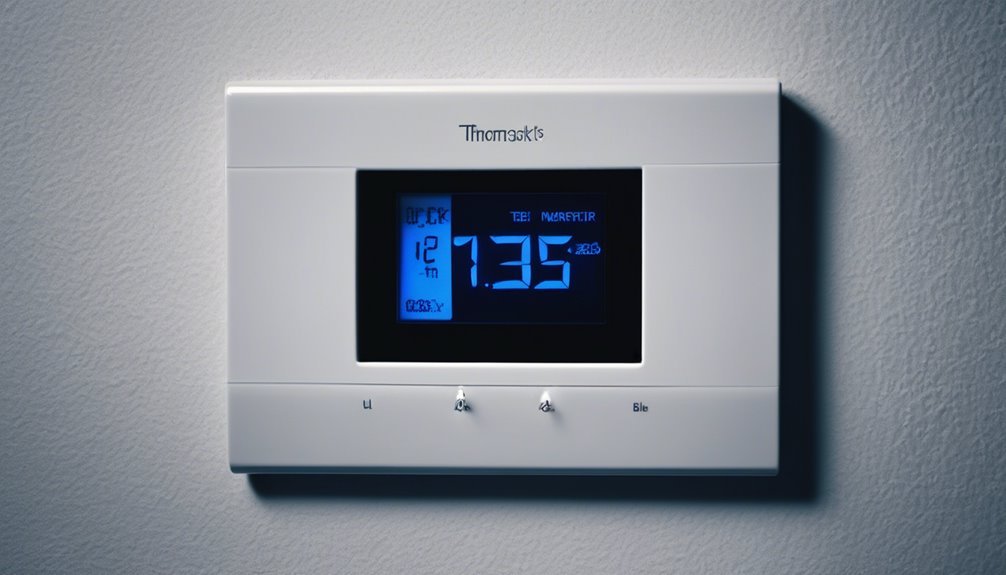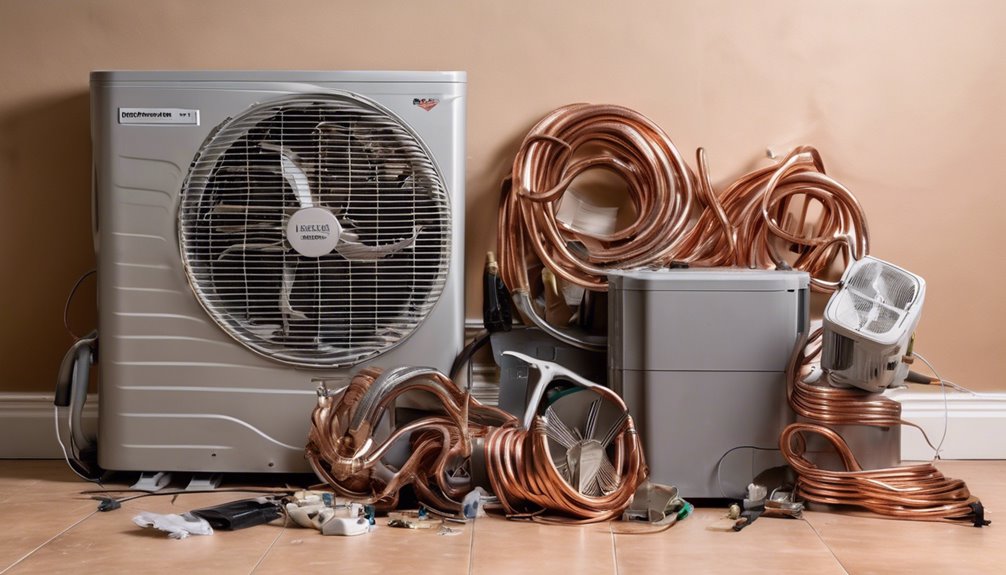When your AC thermostat isn't working right, it can be a real hassle – inconsistent temps, sky-high energy bills, and even breakdowns. You're not alone! Common issues include faulty temperature readings, uneven cooling patterns, and wiring problems. Don't forget to check for dead batteries, incorrect installations, and incompatibility with your AC unit. Take a closer look at these potential causes, and you'll be on your way to getting your thermostat back on track and your home comfortable again.
Key Takeaways
- Faulty wiring, dead batteries, and incorrect calibration can cause thermostat malfunctions, leading to discomfort and energy inefficiency.
- Incorrect thermostat placement, such as near heating vents or windows, can lead to inaccurate temperature readings and system failures.
- Incompatibility between the thermostat and AC unit can result in inefficient cooling, increased energy bills, and system breakdowns.
- Regular cleaning and calibration can prevent thermostat problems, while understanding thermostat history can help identify potential issues.
- Troubleshooting wiring issues involves checking for loose connections, miswired terminals, and damaged wires to resolve thermostat malfunctions.
Common Thermostat Problems
You're probably no stranger to thermostat troubles, especially during extreme weather conditions.
From faulty wiring to dead batteries, thermostat issues can be frustrating and disrupt your comfort at home.
Did you know that thermostat maintenance is crucial to prevent these problems?
Regular cleaning and calibration can go a long way in ensuring your thermostat functions smoothly.
Understanding thermostat history can also help you identify potential issues.
For instance, older thermostats may be more prone to malfunctioning due to outdated technology.
Faulty Temperature Readings
You're likely familiar with the frustration of an AC thermostat that's not quite getting it right.
But what's behind those faulty temperature readings? It's often a combination of incorrect calibration methods, sensor malfunction symptoms, and environmental interference factors that throw off your thermostat's accuracy.
Incorrect Calibration Methods
When your AC thermostat is incorrectly calibrated, it can lead to faulty temperature readings, which in turn affect the overall performance of your cooling system.
Calibration errors often occur due to human mistakes during the installation process. This can include miscalibrating the thermostat's temperature sensor or failing to follow the manufacturer's calibration instructions.
As a result, your thermostat may display incorrect temperature readings, causing your AC to malfunction. For instance, if your thermostat thinks it's 80°F when it's actually 75°F, your AC will continue to run unnecessarily, wasting energy and increasing your bill.
To avoid this, ensure you follow the correct calibration procedure and double-check your work to prevent human mistakes.
Sensor Malfunction Symptoms
A malfunctioning temperature sensor in your AC thermostat can cause faulty temperature readings, leading to inefficient cooling and unnecessary energy consumption.
If you notice your thermostat is consistently misreading the temperature, it may be due to a sensor malfunction. You might experience sensor drift, where the temperature reading gradually becomes inaccurate over time.
Another common issue is dirty sensors, which can cause your thermostat to misread the temperature. Check your sensor for dust, dirt, or other debris that may be affecting its accuracy.
Cleaning the sensor can often resolve the issue. If the problem persists, it may be time to replace the sensor altogether to ensure your AC is running efficiently and effectively.
Environmental Interference Factors
Faulty temperature readings can also stem from environmental interference factors.
You mightn't think about it, but your surroundings can affect your thermostat's accuracy.
- Humidity effects: High humidity can cause your thermostat to misread temperatures, leading to incorrect heating or cooling.
- Electromagnetic interference from nearby devices, like cordless phones or microwaves, can disrupt your thermostat's signal.
- Direct sunlight can heat up your thermostat, causing it to read higher temperatures than the actual room temperature.
- Drafts from windows, doors, or air vents can also affect temperature readings.
- Physical obstructions, such as furniture or curtains, can block air vents and impact temperature readings.
Uneven Cooling Patterns
How does your AC thermostat know when to cool one room more than another? It's not magic, but rather a system of cooling zones.
Your thermostat is designed to prioritize certain areas of your home, but sometimes this can lead to uneven cooling patterns.
If you notice some rooms are consistently hotter or colder than others, it might be due to airflow blockages. Check for closed vents, furniture obstructing airflow, or dirty air filters that could be restricting the flow of cool air.
Thermostat Not Turning On or Off
When your thermostat isn't turning on or off, it's frustrating and can leave you wondering what's going on.
You're likely suspecting that there's an issue with the thermostat itself, and you're right.
Faulty wiring or dead batteries might be the culprits, and it's time to investigate these potential causes.
Faulty Thermostat Wiring
Many homeowners have experienced the frustration of a thermostat that refuses to turn on or off, leaving them sweltering in the summer or shivering in the winter.
If you're dealing with this issue, it's likely due to faulty thermostat wiring. This can cause your thermostat to malfunction, resulting in inconsistent temperatures and discomfort.
- Wire corrosion: Check for signs of corrosion or rust on the wires, which can prevent the thermostat from functioning properly.
- Loose connections: Verify that all connections are secure and not loose, as this can disrupt the flow of electricity.
- Incorrect wiring: Ensure that the wiring is correctly connected to the thermostat and HVAC system.
- Damaged wires: Inspect the wires for any signs of damage, such as fraying or cuts.
- Outdated wiring: If your wiring is old, it may be outdated and incompatible with your current thermostat or HVAC system.
Dead Battery Issues
Your thermostat's refusal to turn on or off can be frustrating, especially when you're left sweating in the summer or freezing in the winter.
One common culprit behind this issue is a dead battery. If your thermostat relies on batteries, it's essential to check them regularly.
You might be surprised to find corrosion on the terminals, which can prevent the thermostat from functioning. Replace the batteries with fresh ones, making sure to clean the terminals to remove any corrosion.
Typically, thermostat batteries last around a year, depending on usage and quality. Keep an eye on your thermostat's battery lifespan to avoid sudden failures.
Incorrectly Installed Thermostats
Incorrectly installed thermostats can lead to a plethora of problems, including inaccurate temperature readings, uneven heating or cooling, and even system failures.
You might be wondering how to avoid these issues. The key lies in proper thermostat placement and following a thorough installation checklist.
Proper thermostat placement and a thorough installation checklist are key to avoiding common issues and ensuring optimal performance.
Here's what you should keep in mind:
- Ensure the thermostat is installed at least 5 feet away from any heating or cooling vents.
- Avoid placing the thermostat near windows, doors, or areas with high air leakage.
- Keep it away from direct sunlight, radiators, and heaters.
- Install the thermostat on an interior wall, rather than an exterior one.
- Make sure it's level and securely fastened to the wall.
Dead Batteries or Low Power
Now that you've ensured your thermostat is properly installed, it's time to consider another common issue that can throw your AC system off kilter: dead batteries or low power. Weak or dead batteries can cause your thermostat to malfunction, leading to inconsistent temperatures and energy waste. To diagnose the issue, perform a power diagnostic check to assess your thermostat's battery health.
| Symptom | Solution |
|---|---|
| Thermostat screen is blank | Replace batteries or charge them according to the manufacturer's instructions |
| Thermostat is slow to respond | Check for corrosion on the battery terminals and clean them if necessary |
| Thermostat is not maintaining set temperatures | Consider upgrading to a thermostat with a more efficient power source, such as a hardwired or solar-powered model |
Thermostat Wiring Issues
Faulty thermostat wiring can be a significant obstacle to your AC system's optimal performance.
When you're troubleshooting wiring issues, it's essential to consult your thermostat's wiring diagrams to identify the problem. Make sure you understand the wire colors and their corresponding functions.
Here are some common wiring issues to check:
- Loose or corroded connections
- Miswired thermostat terminals
- Incorrectly sized wires
- Damaged or pinched wires
- Incorrect wire color assignments
Incompatibility With AC Unit
Your AC thermostat is only as good as its compatibility with your AC unit. If they're not a match made in heaven, you'll experience AC incompatibility issues.
A thermostat mismatch can lead to inefficient cooling, increased energy bills, and even system breakdowns.
Incompatible thermostats can spark inefficient cooling, skyrocketing energy bills, and even catastrophic system failures.
Make sure your thermostat is compatible with your AC unit's features, such as zoning systems, heat pumps, or smart technology.
Check the thermostat's specifications and your AC unit's manual to ensure they're compatible. If you're unsure, consult a professional to avoid any potential damage or safety hazards.
Don't risk your comfort and wallet; ensure a harmonious relationship between your thermostat and AC unit to keep your home cool and comfortable.
Frequently Asked Questions
Can I Use a Programmable Thermostat With a Heat Pump?
You can use a programmable thermostat with a heat pump, but ensure Heat Pump Compatibility and proper Thermostat Integration to avoid damaging the system; check the thermostat's specifications and heat pump's requirements for a seamless setup.
How Do I Reset My Thermostat After a Power Outage?
After a power loss, you'll need to reset your thermostat to get it up and running again. Simply turn the thermostat off, wait 30 seconds, and then turn it back on to complete the reboot.
Can I Install a Smart Thermostat Myself?
You're considering DIY installation of a smart thermostat, but before you start, ensure you've checked the compatibility of your new device with your HVAC system to avoid any potential issues or voiding the warranty.
Do I Need to Clean My Thermostat Regularly?
You should regularly clean your thermostat to prevent dust buildup, which can affect its accuracy. Don't forget to check and maintain your air filter, as a dirty filter can also impact your thermostat's performance.
Can I Use a Thermostat With a Zoning System?
You're considering a zoning system, and wondering if your thermostat is compatible. Luckily, many modern thermostats are designed for zoning compatibility, allowing seamless system integration and customized temperature control in different zones of your home.
Conclusion
You've made it to the end of this troubleshooting guide, and hopefully, you've identified and fixed your AC thermostat issues. Remember, a faulty thermostat can lead to energy waste, discomfort, and even AC unit damage. By being proactive and addressing common problems like temperature readings, cooling patterns, and wiring issues, you'll ensure your AC runs efficiently and effectively. Stay cool!



